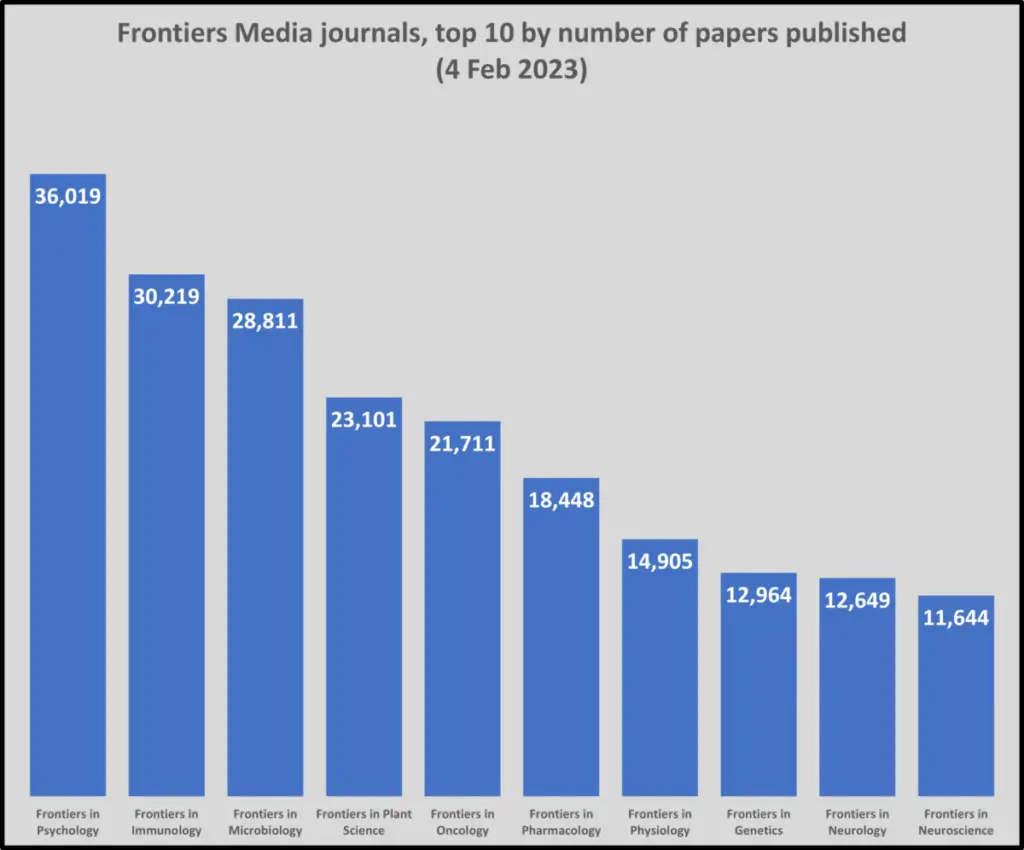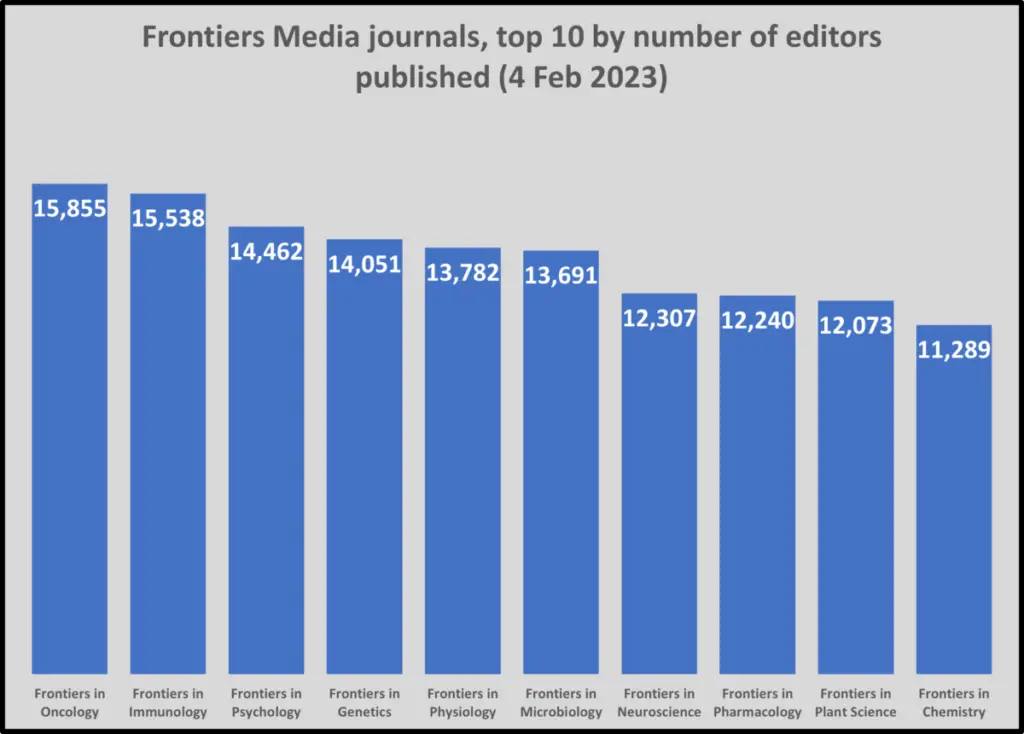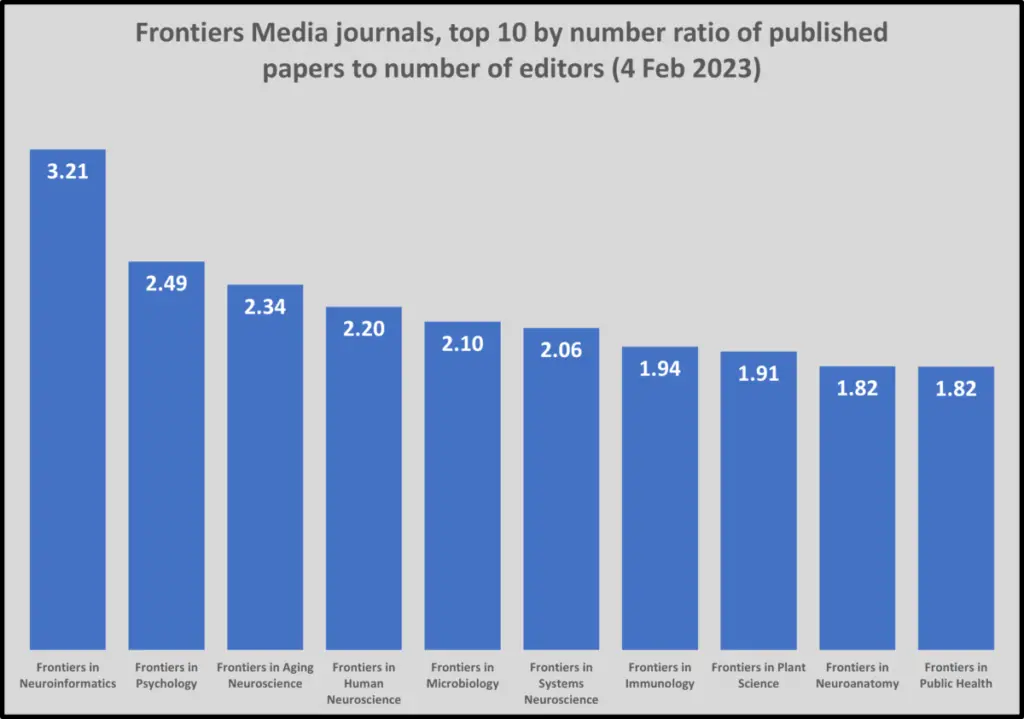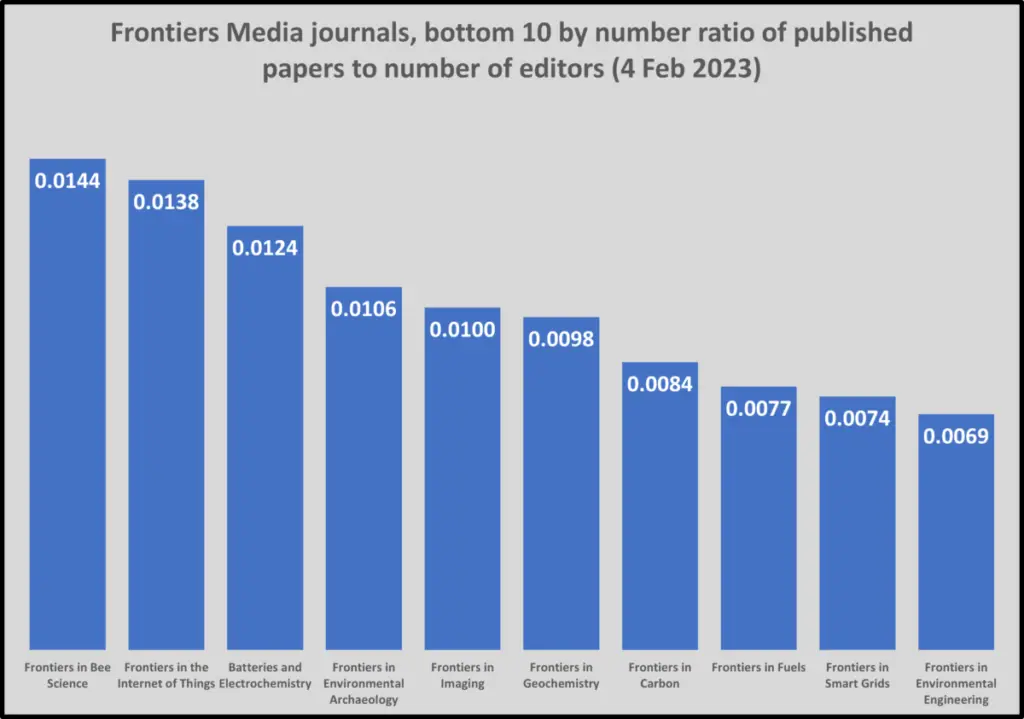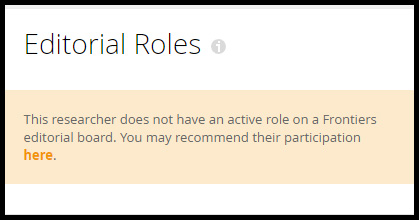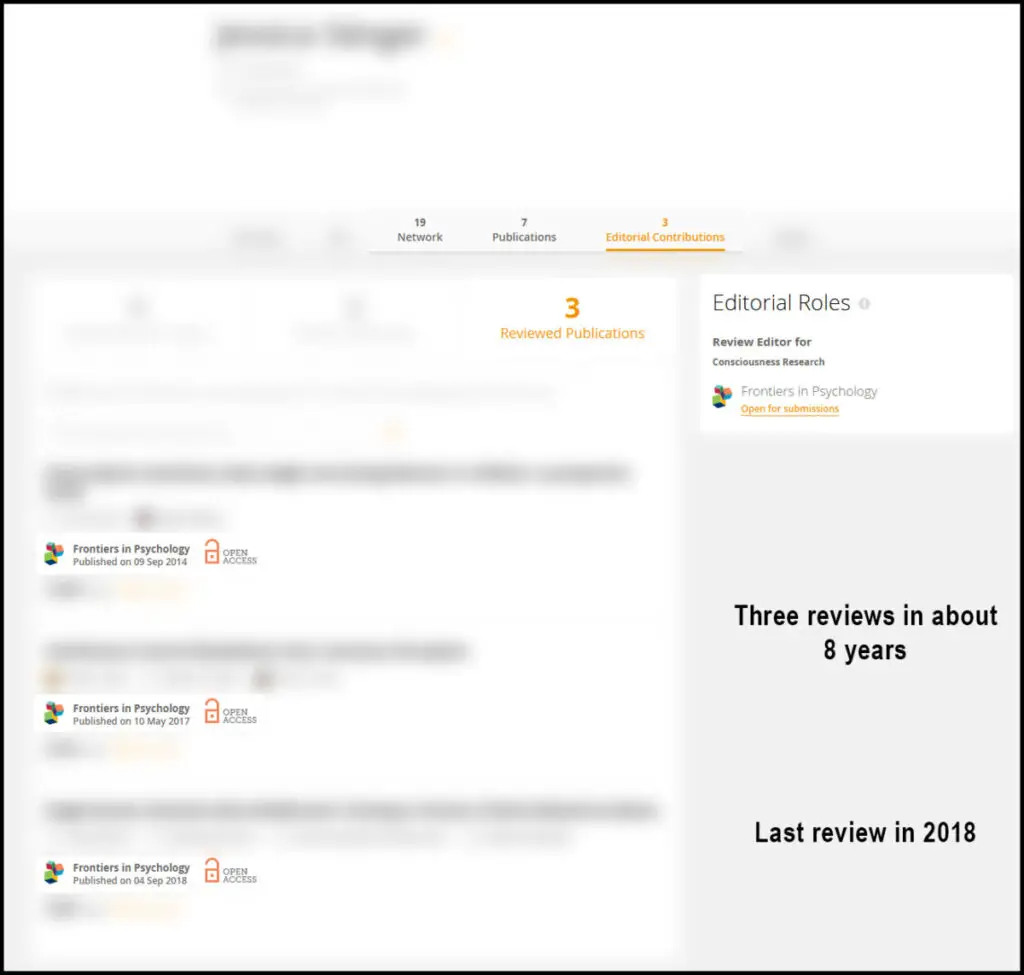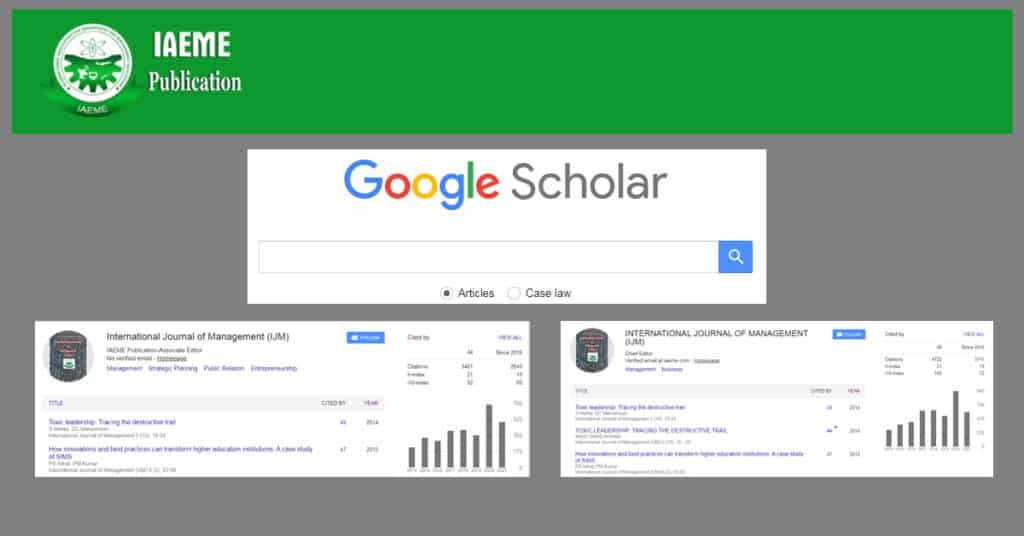When looking at Frontiers Media for a recent article we wrote on the outcome of a Twitter survey, something caught our eye. Compared to other journals/publishers, we were surprised by the number of editors that Frontiers Media have. They often have more editors than the number of papers that the journal has published, suggesting that each editor is handling less than one paper or, to put it another way, some editors are not handling any papers.
We thought we would investigate and just put some facts before you and also try and understand why a journal would have/need so many editors.
We are not concluding from this study that Frontiers Media, or its journals, are predatory. We have not done anywhere near enough research to arrive at a conclusion either way.
If you are interested in this discussion, you may want to read the Wikipedia entry (accessed 05 Feb 2023) which states that Frontiers Media is a member of organizations such as COPE, DOAJ and OASPA, as well as discussing some of the controversies that surround this publisher.
Therefore, this article should be viewed as an informational data point, along with a request for feedback/clarification from the publisher.
Note: We have revisited this article, following a conversation we had on Twitter. After reading this article, we suggest that you also the article where we revisit this topic.
Data Collection
The data for this article was collected on the 04 February 2023.
The Frontiers Media web site lists 192 journals.
Most of the journals (182) are called “Frontiers in …“, with the remaining 10 journals not being called Frontiers.
One journal, Frontiers for Young Minds, is edited by “kids and teens”. This journal does not provide the number of editors, in the same format that the other “Frontiers in …” journals do (noting it is called “Frontiers for …“). Some of the reviewers are as young as 8 years old (and perhaps there are some that are even younger). This journal is very interesting in its concept, but we will not dwell on it further in this article.
Collecting editor and article counts
The data for each journal was collected by accessing its home page and collecting the journal name, the number of editors and the number of articles. This information is given by each journal (mostly, but see below), which made it relatively easy to collect the data and it meant (thankfully) that there was no need to collect each separate editor and article and then count the number of records collected.
As an example, Frontiers in Aging says that it has 961 editors and has published 226 articles (see Figure 2).
Some of the journals, however, do not present this information. This is primarily those journals that are not called “Frontiers in …” and new journals, which (we assume) do not have a track record to report as yet.
For those journals where we could collect data, we have set up a separate page, where each journal is shown.
The journals where the editor/article data is not readily available is given below. These (28) journals are excluded from the analysis presented in the rest of this article.
- Dystonia
- Earth Science, Systems and Society
- Frontiers for Young Minds
- Frontiers in Amphibian and Reptile Science
- Frontiers in Antennas and Propagation
- Frontiers in Audiology and Otology
- Frontiers in Cell Death
- Frontiers in Energy Efficiency
- Frontiers in Environmental Health
- Frontiers in Ethology
- Frontiers in Evolutionary Neuroscience
- Frontiers in High Performance Computing
- Frontiers in ICT
- Frontiers in Industrial Engineering
- Frontiers in Industrial Microbiology
- Frontiers in Lupus
- Frontiers in Malaria
- Frontiers in Mammal Science
- Frontiers in Neuroenergetics
- International Journal of Public Health
- Oncology Reviews
- Pathology and Oncology Research
- Public Health Reviews
- Spanish Journal of Soil Science
- Transplant International
Analysis
Top 10 journals, by number of articles
Figure 3 shows the top ten journals, with respect to the number of articles that they have published (as at 4 Feb 2023). The full set of data is available here.
It is apparent that Frontiers Media have a number of journals that have good track records, and have published a large number of papers. For example, Frontiers in Psychology have published 36,109 articles (as at 4 Feb 2023) since it started in March 2010. It is now publishing Volume14, meaning that it has published over 2,500 papers each year.
Top 10 journals, by number of editors
Figure 4 shows the top ten journals, with respect to the number of editors for the given journal (as at 4 Feb 2023). The full set of data is available here.
It was these figures that motivated us to write this article. We have not previously seen journals with so many editors. That is not to say that there are not any, we have just not seen them.
We again emphasize that this does not mean that these journals are predatory. There would have to be a much deeper investigation to arrive at a conclusion either way.
The ratio of editors to articles published
In some ways, just presenting the number of editors (or articles) in meaningless. It is the relationship between those two sets of figures that is more insightful.
In Figure 5, we show the ratio between the number of editors and the number of articles that the journal has published. We show the top ten journals with the highest ratios. The full set of data is available here.
The ratio is calculated by dividing the number of articles by the number of editors. This indicates how many papers each editor has handled. We are making the assumption that a single editor handles a paper, rather than the editorial members being reviewers, as well as editors. We say a little more about this below, as it a certainly not the case.
Looking at Figure 5, the editors for Frontiers in Neuroinformatics, on average, has handled 3.21 papers. This is calculated by dividing the number of papers that the journal has published (924), by the number of editors (288). That is 924/288 = 3.21.
An editor handling just over three papers might seem reasonable, but this must be taken in the context that these figures represent the lifetime of the journal. Frontiers in Neuroinformatics started publishing in November 2007; that is about 15 years ago. This means that each editor has handled (3.21/15) = 0.21 papers. This means that the majority of editors have never handled a paper for this journal.
The next journal (Frontiers in Psychology) has published 36,019 articles and has 14,462 editors (so a ratio of 2.49 papers handled by each editor). This journal started published in Jan 2011 (so about 12 years ago), meaning that each editor has handled (2.49/12) = 0.21 papers.
We have not carried this analysis any further, but it would make an interesting study to develop this analysis into a full data set of all journals. However, from our limited analysis, we believe it shows that the editors of Frontiers Media journals do not handle many papers.
Figure 6 shows the other end of the spectrum. That is, those journals that have the lowest number of papers being handled by the editors. For example, Frontiers in Environmental Engineering has published three articles and has 434 editors (so a ratio of 0.0069). This journal has only been publishing since December 2022.
Editors and/or Reviewers
There are different categories of editorial activity, such as “Associate Editor” and “Review Editor“. See, for example, the editorial board for this journal (accessed 4 Feb 2023).
Looking at the peer review page of Frontiers Media, it says:
“If a manuscript is sent for peer review, the handling editor is accountable for inviting and overseeing expert reviewers. Most article types require at least two reviewers to complete a review. These reviewers can either be invited from the board of review editors or appropriately recruited among experts in the field.“
That is, those people listed as editors, on a journal’s web site, actually comprise both editors and reviewers. This is concerning for a few reasons:
- You have to realize that this is the case.
- It is not how most journals operate. Most journals acknowledge their reviewers in other ways (for example, by listing them annually).
- Some reviewers may take the opportunity to list themselves as editorial board members of the Frontiers journal (for example on their CV), which can be verified by others by accessing the journal’s web site (and looking under the “Editorial Board” tab). At best, this is not representing actuality.
Case studies
We checked a number of reviewers and looked them up on the Frontiers web site. This is not as easy as you might expect as the editors are listed on a scrolling web page and to ascertain whether an editor is listed is time consuming especially when the journal has thousands of editors.
We were able to carry out some Google searches to find the information we needed, but an easier interface would be welcomed.
When a given person has acted as a reviewer, but is not listed on any editorial board, the message shown in Figure 7 is shown.
Figure 8 shows an example of somebody who is an active editorial board member. We have anonymized the person, to protect their identity, but have shown relevant information.
Figure 8 shows that the person has reviewed three papers since 2014, with their last review being carried out over four years ago (in 2018).
We would question whether this person (and there may be many others) should i) be listed as an editorial board member (as they are a reviewer) and ii) whether they should be listed now as they last carried out a review in 2018.
Any views you have would be welcomed.
Further comments
If we assume that each paper is reviewed by two people, drawn from the editorial board or from external sources, then the ratios given above can be doubled. We would argue that this still does not lead to editors that are overly busy?
We could be more explicit and look again at Frontiers in Environmental Engineering. They have published three papers (let’s say 6 reviews). Let’s also assume that they have another 50 articles in process (another 100 reviews). With 434 serving editors (and access to external reviewers), that leaves well over 300 members of the editorial board who have not handled, or reviewed, a paper.
It would make an interesting study to look at every journal in much more detail that we have here and it would also be useful (and right) to get feedback/views from the publishers/journals/editors, as our working assumptions, and thus conclusions, may be incorrect.
Final thoughts
The catalyst for this article was when we saw how many editors serve on “Frontiers in …” journals, often many thousands. This seemed high to us, even if we assume that some (many?) of these editors serves as reviewers. The full set of data is available here.
We still hold the view that Frontier Media’s journals have a high number of editors. Moreover, listed reviewers as editorial board members is confusing as it is not how the vast majority of this sector operates.
We note that Frontiers are transparent about the way they operate and also make a point of listing those that act as reviewers on the finally accepted paper but we feel that, as the majority of the sector operates differently, this make their practices a little opaque.



